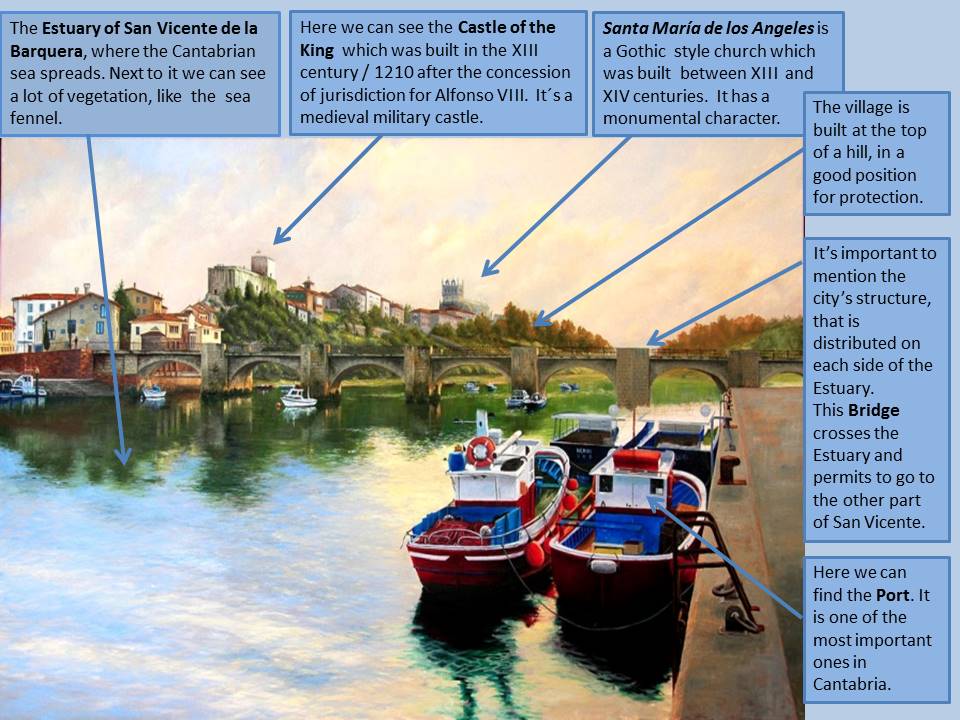SAN VICENTE DE LA BARQUERA (Javier Ibarrondo Los Arcos, 2013)
This work of art belongs to Javier Ibarrondo los Arcos and it was created in 2013. It is an oil on canvas painting and represents the city of San Vicente de la Barquera (Cantabria), located in the north of Spain, next to the province of Asturias. The painting was taken from the website Artelista.com. It has been depicted by looking at the city from the port and with the ships right in the foreground. The artist truly represents the fishing character of the city.
The city had a population of 4,344 in 2013. The climate is soft and, generally, hot and moderate. It rains more in the winter that in summer and the annual average temperature is 14.4°C. Some definitive factors that influence where the city was originally built are: the proximity to the water, as the estuary has developed a fishing activity and the port is one of the most important ones in the Cantabrian sea; the amount of vegetation, as we can find the Oyambre Natural Reserve in the proximity; the topography, because the hill surrounded by the river facilitates defense, etc. This place also takes part of the Camino Lebaniego, which connects the coastal route of the Way of Saint James to the principal French route. As a remarkable fact, San Vicente de la Barquera turned into one of the Four Villas of the sea of Castilla in 1330. This means to be a port enclave that allow the exit to the sea from the Central Meseta.
In the image we can appreciate that the city has an irregular urban layout. The hill follows the typical characteristics of a medieval settlement with clustered houses and narrow streets. It is clear to see the urban structure that is divided in two parts by the estuary. The old quarter is located at the top of a limestone crag, and it is surrounded by a crenellated wall and several gates, where two emblematic buildings stand out.
The first one is the Church of Santa María de los Ángeles, located in one of the highest points of the old quarter, in a square protected by low walls. It has 3 gates, naves with larger space, slim pillars and pointed arches. All this give the temple a monumental character. Here we can find a funeral piece of the inquirer, and it is one of the most interesting ones of this period in Spain. It has been attributed to Juan Bautista Vázquez.
The second monument is the Castle of the King, which was built in 1210 after the concession of jurisdiction for Alfonso VIII. It counts with two towers, one with a pentagonal plant and the other one with a square plant, joined by a rectangular court of weapons. From this castle there were departing the walls of which still have nowadays some sections. It is placed on a rocky mound that provides a defensive aspect, very typical among the buildings of that time.
There are other interesting buildings, such as the House of the Inquirer Corro, nowadays the Town Hall, with a Renaissance trace, and the Former Hospital of the Concepcion, now in ruins, with a beautiful façade. In addition, it is important to mention the High Street, crossing the Bridge of the Maza and then turning to the left, as well as the irregular, narrow and steep medieval street along the old quarter. On the contrary, outside the walls there is the modern town following a grid plan. Today the main economic activities in this village are fishing and tourism. San Vicente de la Barquera offers several beaches and attractions for visitors so that tourism is one of the most important activities nowadays.
Noelia Molina Serna

